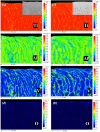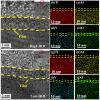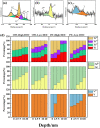Effect of low dissolved oxygen concentration on the defects and composition of regenerated passive film of Ti-6Al-4V alloy under continuous wear
- PMID: 37416911
- PMCID: PMC10320359
- DOI: 10.1039/d3ra03865c
Effect of low dissolved oxygen concentration on the defects and composition of regenerated passive film of Ti-6Al-4V alloy under continuous wear
Abstract
Tribocorrosion is one of the most common forms of failure of biomedical titanium alloys. As the passive film of titanium alloys is highly dependent on oxygen conditions, the passivation behavior and the microstructure of the passive film of Ti-6Al-4V under tribocorrosion in 1 M HCl with a low dissolved oxygen concentration (DOC) were studied by means of electron probe microanalysis (EPMA), Ar-ion etched X-ray photoelectron spectroscopy (XPS), focused ion beam (FIB) milling and high resolution transmission electron microscopy (HRTEM). The results showed that the protective ability of the regenerated passive film decreased sharply under low DOC. Al and V ions dissolved in excess, and a large number of oxygen atoms entered the matrix, leading to internal oxidation. Structural characterization indicated that Ti atoms occupied more metal lattice points in the regenerated passive film and that the high dislocation density in the deformed layer caused by wear facilitated the diffusion of Al and V. Finally, the first-principles calculation showed that Al had the minimum vacancy formation energy.
This journal is © The Royal Society of Chemistry.
Conflict of interest statement
There are no conflicts to declare.
Figures















Similar articles
-
In-situ monitoring of the electrochemical behavior of cellular structured biomedical Ti-6Al-4V alloy fabricated by electron beam melting in simulated physiological fluid.Acta Biomater. 2020 Apr 1;106:387-395. doi: 10.1016/j.actbio.2020.02.008. Epub 2020 Feb 11. Acta Biomater. 2020. PMID: 32058079
-
Influence of Ru on structure and corrosion behavior of passive film on Ti-6Al-4V alloy in oil and gas exploration conditions.Sci Rep. 2022 Oct 5;12(1):16586. doi: 10.1038/s41598-022-21047-0. Sci Rep. 2022. PMID: 36198740 Free PMC article.
-
Fretting corrosion behaviour of Ti-6Al-4V reinforced with zirconia in foetal bovine serum.J Mech Behav Biomed Mater. 2019 Dec;100:103392. doi: 10.1016/j.jmbbm.2019.103392. Epub 2019 Aug 6. J Mech Behav Biomed Mater. 2019. PMID: 31430704
-
Study on improved tribological properties by alloying copper to CP-Ti and Ti-6Al-4V alloy.Mater Sci Eng C Mater Biol Appl. 2015 Dec 1;57:123-32. doi: 10.1016/j.msec.2015.07.046. Epub 2015 Jul 29. Mater Sci Eng C Mater Biol Appl. 2015. PMID: 26354247
-
Comparative analysis of corrosion resistance between beta titanium and Ti-6Al-4V alloys: A systematic review.J Trace Elem Med Biol. 2020 Dec;62:126618. doi: 10.1016/j.jtemb.2020.126618. Epub 2020 Jul 9. J Trace Elem Med Biol. 2020. PMID: 32663743
Cited by
-
Enhanced biological performance of Sr2+-doped nanorods on titanium implants by surface thermal-chemical treatment.J Mater Sci Mater Med. 2025 Jun 23;36(1):54. doi: 10.1007/s10856-025-06898-z. J Mater Sci Mater Med. 2025. PMID: 40549257 Free PMC article.
References
-
- Huang Y. Huang J. Yu X. Yu S. Fan D. Microstructure characterization and texture evolution of Ti-6Al-4V cladding layer fabricated by alterative current assisted TIG. Surf. Coat. Technol. 2022;431:128014.
-
- Dutta B. Froes F. H. S. The Additive Manufacturing (AM) of titanium alloys. Metal Powder Report. 2017;72:96–106.
-
- Cvijović-Alagić I. Cvijović Z. Mitrović S. Panić V. Rakin M. Wear and corrosion behaviour of Ti–13Nb–13Zr and Ti–6Al–4V alloys in simulated physiological solution. Corros. Sci. 2011;53:796–808.
-
- Zhang M. Xin L. Ding X. Zhu S. Wang F. Effects Ti/TiAlN composite multilayer coatings on corrosion resistance of titanium alloy in solid NaCl-H2O-O2 at 600°C. J. Alloys Compd. 2018;734:307–317.
-
- Lomholt T. C. Pantleon K. Somers M. A. J. In-vivo degradation mechanism of Ti-6Al-4V hip joints. Mater. Sci. Eng., C. 2011;31:120–127.
LinkOut - more resources
Full Text Sources
Research Materials

